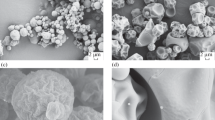Changes in porosity at micro- and nanoscale levels in ultra-high-molecular-weight polyethylene (UHMWPE) fibers obtained by gel spinning molding were investigated by weighing, as well as by scanning electron microscopy and X-ray diffraction at high and low angles, depending on the orientational draw ratio and the medium (solvent or air). It was found that the total porosity of the fibers decreases significantly at the initial stages of stretching during the transition from a xerogel with a cellular structure of micron-sized pores to fibers with a fibrillar structure. At draw ratios λ of 9 to 30 for fibrillar structure fibers drawn in a vaseline oil medium, anisotropic pores with a longitudinal dimension along the fiber axis of several fractions of a micrometer and a transverse dimension of 1-10 nm appeared. At high draw ratios λ > 40, the nanopores practically disappeared, and the crystalline phase of nanofibrils acquired continuity and homogeneity. The elastic-strength characteristics of the fibers increased most significantly at the initial stages of stretching (up to λ = 9-15) with a radical rearrangement of the supramolecular structure, when the total porosity of the fibers decreased sharply. A further noticeable increase in the strength and modulus of elasticity of the fibers was observed at high draw ratios in air (λ > 30). Under these conditions, the content of nanopores sharply decreased, and nanofibrils had a paracrystalline structure.



Similar content being viewed by others
References
P. G. Cheremskiy, V. V. Slezov, and V. I. Betekhtin, Pores in a Solid [in Russian], Energoatomizdat, Moscow (1990) 373 p.
A. I. Petrov, M. V. Razuvaeva, et al., Mekhanika Kompozitsionnykh Materialov (Mechanics of Composite Materials), 6, 121-1125 (1989).
S. P. Pankov, Theoretical Foundations for the Production of Chemical Fibers [in Russian], Khimiya, Moscow (1990) 272 p.
P. M. Pakhomov, V. P. Galitsyn, et al., High-Strength and High-Modulus Polymer Fibers [in Russian], TvGU, Tver (2012) 327 p.
P. M. Pakhomov, A. Yu. Golikova, et al., Fizikokhimiya Polimerov (Physicochemistry of Polymers), Issue 12, 23-29, Tver (2006).
G. K. Elyashevich, I. S. Kurindin, et al., Fiz. Tverd. Tela, 54, Issue 9, 1787-1796 (2012).
P. M. Pakhomov, T. Rojter, et al., Doklady RAS, 39, No. 2, p. 215 (2003).
A. Peterlin, J. Macromol. Sci. Part Â, 7, No. 4, 705-714 (1973).
P. Pakhomov, S. Khizhnyak, et al., Polymer, 44, 4651-4654 (2003).
P. Pakhomov, A. Golikova, et al., Fibre Chemistry, 38, No. 3, 200-206 (2006).
V. A. Marikhin and L. P. Myasnikova, Vysokomol. Soed. A, 32, No. 11, 2378 (1990).
E. Antipov, Yu. Lebedev, et al., Polymer. Sci. (Russia), 49A, No. 6, 663-670 (2007).
P. Pakhomov, S. Khizhnyak, et al., Fibre Chemistry, 45, No. 6, 343-449 (2014).
Author information
Authors and Affiliations
Corresponding author
Additional information
Translated from Khimicheskie Volokna, No. 5, pp. 37 – 42, September – October, 2020.
Rights and permissions
About this article
Cite this article
Pakhomov, P.M., Sokolov, A.V., Khizhnyak, S.D. et al. Influence of Porosity on the Mechanical Characteristics of UHMWPE Fibers Obtained by the Gel Spinning Molding Method. Fibre Chem 52, 356–361 (2021). https://doi.org/10.1007/s10692-021-10212-2
Published:
Issue Date:
DOI: https://doi.org/10.1007/s10692-021-10212-2



